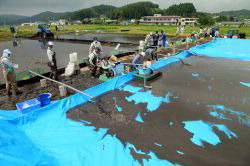Editorial: Latest
Radiation-Tainted Rice Case Shows Gov't Must Better Safety
Measures

Fukushima Power Plant
EMF Protection Devices
Magnetic Field Detector
Rice harvested this fall in the city of Fukushima's Onami
district registered radioactive cesium levels of 630
becquerels per kilogram, exceeding the government limit of
500 becquerels. The government has since ordered Fukushima
Prefecture to ban shipments of rice from the area.
As none of the rice samples from Onami that had been tested
before and after harvest were found to have radiation levels
above the maximum limit, the rice had previously been
cleared for distribution. In other words, had rice farmers
not submitted samples for voluntary testing, it was possible
that the rice could have reached the market. To protect the
public, the government must get to the bottom of what caused
such highly concentrated radioactive contamination, and
establish a more reliable testing system.
After the nuclear crisis in Fukushima began, the government
restricted rice planting in no-entry zones and other areas
for the year, and additionally implemented a two-step,
pre-harvest and post-harvest testing system in 17
prefectures to prevent the distribution of radiation-tainted
rice. In the latest case, however, contaminated rice slipped
through government safeguards.
http://mdn.mainichi.jp/perspectives/news/20111118p2a00m0na001000c.html
Based on preliminary rice test results, some areas are
designated "priority testing areas" that require close
monitoring of rice for high concentrations of radiation. The
designation, however, only requires further testing of one
sample of rice for every 15 hectares of rice paddy, which is
perfunctory and requires revision.
In September, rice produced in the Fukushima Prefecture city
of Nihonmatsu's Obama district was found in a preliminary
test to have radiation levels exceeding the maximum limit. A
month later, the Fukushima Prefectural Government compiled a
mid-term report saying that the radioactive contamination
found in Obama rice was "an extremely rare" phenomenon,
attributing it to a combination of various factors such as
the conditions of the soil and rice plants, as well as other
environmental factors.
However, the case of Onami rice resembles that of Obama rice
in that it was found to have highly concentrated levels of
radiation. As such, isn't it too soon to conclude that
occurrences of heavily contaminated rice -- like radiation
hot spots -- are "extremely rare?"
Situated in the mountains, the rice paddies in Obama used
mountain runoff as their water source, and some experts say
that high concentrations of cesium could have come from this
runoff. The paddies in Onami are located in hollows and make
use of river water as well, with some suggesting that
radioactive materials in the surrounding environment could
have accumulated in the water.
To protect consumers, it
would be best to test all rice for radiation contamination.
If that is unrealistic, the government at the very least
should run more finely tuned tests on rice grown under
conditions and environments resembling those in the cities
of Fukushima and Nihonmatsu before they reach consumers.
In addition, there is an
urgent need for the government to pinpoint the cause of
contamination. Knowing that will allow us to sort out which
areas should be given testing and decontamination priority,
as well as whether or not rice can be planted next year.
Meanwhile, despite a rice
crop index similar to that of other years, rice prices have
remained high due to lacking supply. The latest case may
drive this trend even further, especially among rice
produced in western Japan, far from the Fukushima power
plant. The government must keep a watchful eye to ensure
safety and fair prices for the public.
(Mainichi Japan) November
18, 2011
http://www.emfnews.org/store
|